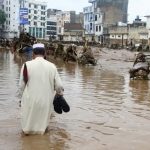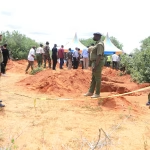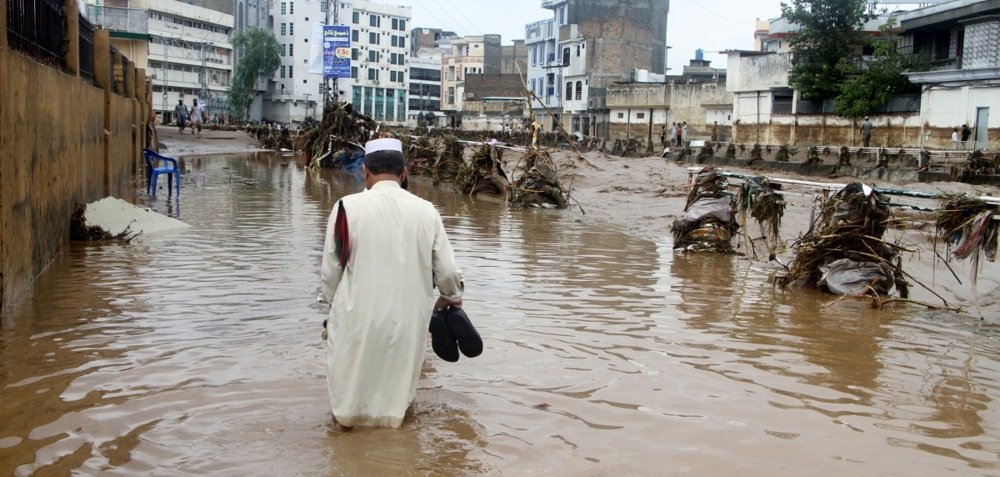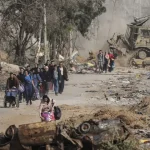South Asia is facing one of the most devastating natural disasters of the year as unprecedented flash floods sweep across the region. Torrential rains have claimed at least 34 lives in Kashmir and forced more than 200,000 people to flee their homes in Pakistan. The floods have overwhelmed infrastructure, destroyed homes, and left communities struggling to cope with the immediate humanitarian crisis.
Experts describe the scale of the disaster as extraordinary, highlighting both the intensity of the monsoon season and the vulnerability of low-lying regions. As emergency teams race to provide aid, the region grapples with questions about disaster preparedness, climate change, and long-term recovery strategies.
The Impact in Kashmir: Lives Lost and Homes Destroyed
In Kashmir, flash floods struck with little warning, submerging entire villages within hours. Local authorities confirmed that 34 people have died, while dozens more are missing. Many of the victims were caught in fast-moving waters while trying to save belongings or assist neighbors.
Officials report that critical infrastructure, including roads and bridges, has been severely damaged. Electricity and communication networks have been disrupted, making rescue efforts increasingly challenging. Residents describe scenes of chaos as homes were swept away, livestock drowned, and crops destroyed.
Eyewitnesses recount the terror of the floods: “Water came suddenly, rising fast. We barely had time to escape,” said a resident of a heavily affected village. Humanitarian organizations are providing immediate assistance, including temporary shelters, food, and medical aid.
Pakistan: Massive Displacement and Widespread Damage
In Pakistan, the situation is equally dire. Heavy monsoon rains triggered flash floods across multiple provinces, displacing over 200,000 people. Entire neighborhoods have been inundated, forcing residents into emergency shelters and temporary camps.
Authorities have reported extensive damage to homes, schools, and hospitals. Roads and bridges connecting rural areas to cities have been washed away, complicating relief operations. The government has deployed military and rescue teams to assist with evacuations and distribute essential supplies.
Health experts warn that stagnant floodwaters could lead to outbreaks of waterborne diseases such as cholera and dengue fever. “Immediate action is needed to provide clean water, sanitation, and healthcare support to prevent secondary crises,” said a senior health official in Pakistan.
Causes Behind the Devastation
Meteorologists point to a combination of factors fueling the disaster. The region is experiencing unusually heavy monsoon rains, amplified by shifting weather patterns linked to climate change. Urbanization and poor drainage systems have worsened the impact of flooding, particularly in densely populated areas.
Experts also highlight deforestation and the destruction of natural flood barriers as key contributors. “When rivers overflow and there is no vegetation to absorb excess water, the result is catastrophic flooding,” said an environmental scientist. These factors, combined with inadequate disaster management infrastructure, have left communities highly vulnerable.
Humanitarian Response: Aid Efforts Underway
International organizations, governments, and local NGOs are coordinating efforts to provide immediate relief. Emergency shelters have been established in both Kashmir and Pakistan, offering displaced families basic necessities such as food, water, and clothing.
Rescue operations are ongoing, with helicopters and boats deployed to reach isolated communities. Medical teams are treating injuries and providing preventive care to minimize the risk of disease outbreaks. Volunteers are working around the clock, often under hazardous conditions, to assist those affected.
Aid agencies have also emphasized the importance of long-term recovery, including rebuilding homes, restoring infrastructure, and providing mental health support to survivors traumatized by the disaster.
Climate Change and Increasing Vulnerability
Scientists warn that events like the South Asia floods are becoming more frequent and severe due to climate change. Rising global temperatures lead to more intense rainfall events, while melting glaciers in the Himalayas contribute to sudden surges in river water levels.
“The intensity of these floods is a wake-up call,” said a climate researcher. “Communities must invest in flood-resilient infrastructure, early warning systems, and sustainable land management to mitigate future risks.”
Urban planning and environmental conservation are critical in reducing the vulnerability of affected regions. Without proactive measures, experts warn, South Asia could face recurring humanitarian crises of this magnitude.
Personal Stories: The Human Cost
Beyond statistics, the floods have left a profound emotional and psychological impact on survivors. Families have lost loved ones, homes, and livelihoods. Children have been separated from parents, and elderly individuals struggle to survive in temporary shelters.
In one village in Kashmir, a young woman recounted how her family escaped a collapsing home: “We climbed to the roof as water rose. Everything else is gone—our house, our animals, our memories.” Stories like these highlight the urgent need for comprehensive disaster response and support for affected communities.
Lessons in Preparedness
While natural disasters cannot always be prevented, preparedness can significantly reduce their impact. Experts recommend early warning systems, evacuation plans, and community education on flood safety. Investment in resilient infrastructure, including elevated roads, flood barriers, and efficient drainage systems, can save lives.
Governments and organizations are now evaluating lessons from this crisis to improve future disaster response. Coordination between national and local authorities, effective communication, and rapid deployment of resources are essential components of an effective flood management strategy.
FAQs
What caused the flash floods in South Asia?
Heavy monsoon rains, combined with deforestation, poor drainage systems, and climate change, led to the rapid flooding of rivers and low-lying areas.
How many people have been affected?
In Kashmir, at least 34 people have died, while in Pakistan, over 200,000 residents have been displaced from their homes.
What is being done to help survivors?
Governments and humanitarian organizations are providing temporary shelters, food, water, and medical aid. Rescue operations are ongoing to reach isolated communities.
Are the floods linked to climate change?
Yes, climate experts say that rising temperatures and melting glaciers are contributing to more intense rainfall and sudden floods in South Asia.
Q5: How can communities better prepare for future floods?
Investment in resilient infrastructure, early warning systems, evacuation plans, and sustainable land management are key strategies to reduce vulnerability and protect lives.
Conclusion:
The deadly flash floods in South Asia have exposed the vulnerability of communities to extreme weather events. With dozens dead in Kashmir and hundreds of thousands displaced in Pakistan, the scale of the disaster underscores the need for immediate relief, long-term recovery, and climate adaptation measures.
Humanitarian aid is critical now, but governments, communities, and international organizations must also focus on resilience, environmental conservation, and sustainable urban planning to prevent future tragedies. The floods serve as a stark reminder of the destructive power of nature and the urgent need to prepare for a changing climate.














